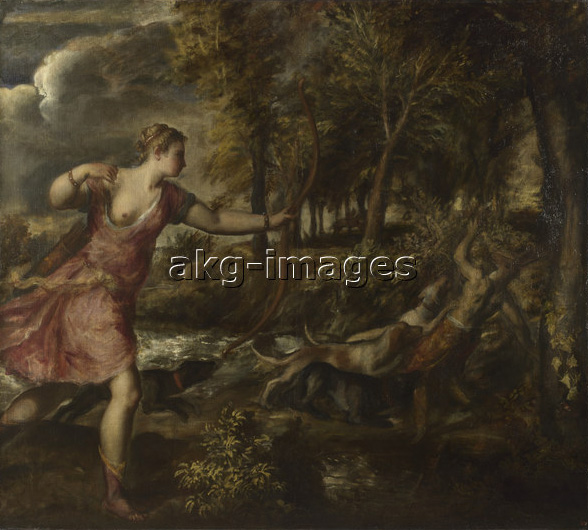Torture on canvas – Titian’s „Flaying of Marsyas“
A few years back I went to one of those blockbuster exhibitions – paintings by Titian in the National Gallery in London. I have to admit that I was never a huge fan of Titian’s work but I do recognise his masterful painterly skills and so I went. It has often been said that Titian was really the first Impressionist and I think that theory is certainly borne out by some of his work. “The Death of Actaeon” in the National Gallery clearly shows impressionist brushstrokes and x-rays have proved that Titian didn’t use any underdrawings in many his works. The painting conveys the illusion of speed extremely well and one can almost hear the rustle of leaves as Diana runs through the woods chasing after Actaeon who is changing into a stag before our very eyes. The whole image is one of haste and chase which is definitely helped by the very loose brushwork Titian uses here.
The image that really stuck in my mind from that exhibition, though, was Titian’s “Flaying of Marsyas”, a pretty huge canvas at 212 x 207cm! The painting shows the moment the satyr Marsyas is being flayed alive for having had the audacity to challenge the god Apollo in a musical contest. The story varies slightly in different sources but the main drift is the same: Marsyas challenges the god Apollo to a musical contest to see who the better musician is; Marsyas on the aulos (a double flute) or Apollo on the lyre. The winner would be allowed to do as he is pleases with the loser and the contest was to be judged by the muses. Needless to say, they chose the god over the satyr and Apollo metered out a very harsh punishment indeed.
It is this moment that Titian has chosen for his monumental canvas; the young satyr strung up between branches and his instrument hung up too. The god Apollo himself (recognisable by his laurel wreath) is doing some of the flaying himself with an intense concentration and a seeming innocence. Another man is working on the satyr’s legs with another figure playing a violin only the left hand side, a macabre musical accompaniment. On the right side of the painting is an even stranger group of onlookers: We see another satyr-like creature, a young boy and an older man with a crown (a remarkable likeness to Titian himself) and two dogs. One, barely held back, seems intent on leaping at Marsyas and a little lap dog, greedily licking up the satyr’s warm blood as it gushes from his wounds. The painting style of this late work by Titian is similar to that of “The Death of Actaeon” – the brushwork is loose and it seems to have been reworked in places creating a frenzied, brutal and almost lusty atmosphere which is only strengthened by Marsyas’s face: full of pain and fear but also resignation to his fate, his big dark eyes shimmer with tears. The canvas feels crowded despite its size and standing in front of the canvas, the viewer is almost at the height of Marsyas’s face and the anguish suffered by this beautiful creature almost seems too much to bear.
Even years after seeing the painting for the one and only time in the original it still haunts me to this day and I have to agree with Iris Murdoch who once called it the greatest painting in the western canon.

